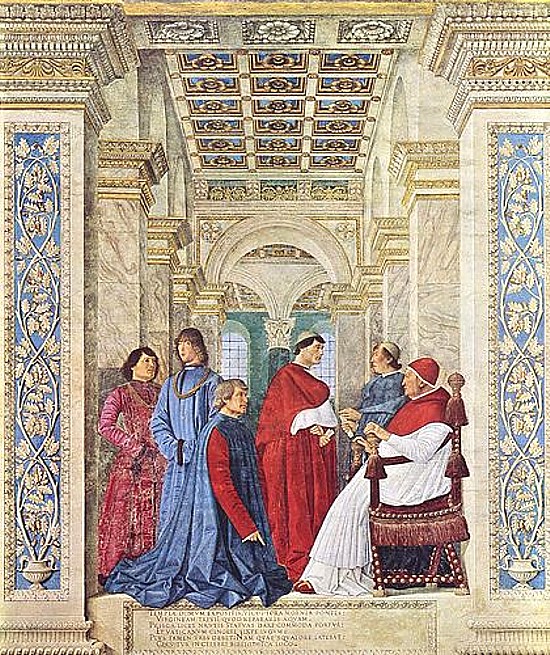 |
| I was unable to determine how many of Melozzo's fresco angels survive. Some sources date them as early as 1472. |
I've sometimes pondered which is the more important, a great artist, or the instructor who taught that artist "everything he knows." I suppose that's something of a chicken or the egg controversy--a rhetorical question more appropriate for discussing than answering. In any case, the "answer" would be more a matter of point of view or bias than definitive. More to the point would be another question; "what the hell difference does it make?"
 |
| You may have to enlarge this page on your screen to read this timeline chart. |
Actually, it makes more difference than you might think. Often in studying art eras of the past, we're so overwhelmed by the plethora of great artists whose creativity and exquisite workmanship we admire to a degree surpassing awe, that we give little thought to the mostly unsung masters of the previous generation who engendered such remarkable works. We might consider the Impressionist era of the latter years of the 19th-century, or the Dutch Golden Age, or the vast flowering of Modern Art of the early 20th-century. Who influenced, who trained, and who sparked the artists of these eras to such greatness? Of course the classic example, and the one most often considered, would be the Italian Renaissance. We have even given the era of these art "instructors" a name. We refer to their period as the "Early Renaissance."
If you think I'm about to launch into a long discourse on the Early Renaissance, think again. Instead, let me pull from this group a single, rather obscure, all but forgotten artist named Melozzo da Forli. Even at that this will be a short discourse in that, aside from his birth date in 1438, almost nothing is known for sure about his early life or art education. His family name was Ambrosi and his "trade" name would suggest he was from the small town of Forli located a little inland on the upper east side of the Italian "boot." I guess I should warn anyone who's into further research on this man that the self-portrait (right) I found more than once misidentified as being the Spanish architect and painter Pedro Machuca, born in 1485. I hate it when that happens.
One fact not uncertain about Melozzo is that he was influenced by Andrea Mantegna, though they were roughly the same age. It's almost literally written all over his work. Melozzo first comes to light sometime between 1460 and 1464. Around this period, along with Antoniazzo Romano, he painted frescoes in the Bessarione chapel in the Basilica dei Santi Apostoli in Rome. Sometime between 1465 and 1474 Melozzo moved to Urbino, where he met Piero della Francesca, who profoundly influenced his style and taught him the use of perspective.
 |
| Pope Sixtus IV appoints Bartolomeo Platina prefect of the Vatican Library, fresco, c. 1477, Melozzo da Forli. |
Melozzo moved back to Rome around 1472-74. There, in 1477, Melozzo completed his first major work, a fresco (now transferred to canvas) representing [Pope] Sixtus IV Appointing Platina as Librarian of the Vatican Library (above). The Triumphant Christ fresco (bottom) was painted during this stint in Rome. After the death of Sixtus IV in 1484, Melozzo moved from Rome to Loreto. There he painted the fresco in the cupola of the sacristy of San Marco in the Basilica della Santa Casa, commissioned by cardinal Girolamo Basso della Rovere. It is one of the first examples of a cupola decorated both with architecture and figures. it greatly influenced the Camera degli Sposi by Mantegna.
 |
| Enlarged section of the dome for the sake of detail. |
 |
| Notice that each figure bears a plaque much like a modern-day cartoon balloon. |
 |
| Melozzo's dome crowned the Basilica della Santa Casa, in Loreto. (The façade was designed by Giovanni Boccalini da Carpi and completed in 1586.) |
When the construction of the Basilica was still in its very early stages some parts of it were already fully decorated. Two octagonal rooms were decorated by Melozzo da Forlì and Luca Signorelli, both leading painters of the time, at the request of Cardinal Girolano Basso Della Rovere, Bishop of Recanati and nephew of Pope Sixtus IV. (The cardinal later became Michelangelo's patron/nemesis, Pope Julius II.) The two rooms are now used as sacristies.
 |
| Ceiling of Sagrestia di S. Giovanni, ca 1479, Luca Signorelli. |
Signorelli did not devote himself to the effects of perspective as did Melozzo in that his angels are portrayed in a rather static pose and remain well inside the frames which surround them. The massive figures of the Evan-gelists/Doctors of the Church painted by Signorelli under the angels anticipate Michelangelo's Prophets/Sibyls in the Sistine Chapel ceiling. However, it's quite obvious that Melozzo's mix-ture of architectural perspective and overriding figures played a much more important role in Michelangelo's conception and design of the Sistine ceiling.
 |
| Triumphant Christ, 1481-83, Melozzo da Forli. Its influence as to Michelangelo's Christ in his Last Judgment is more than a passing resemblance. |



No comments:
Post a Comment